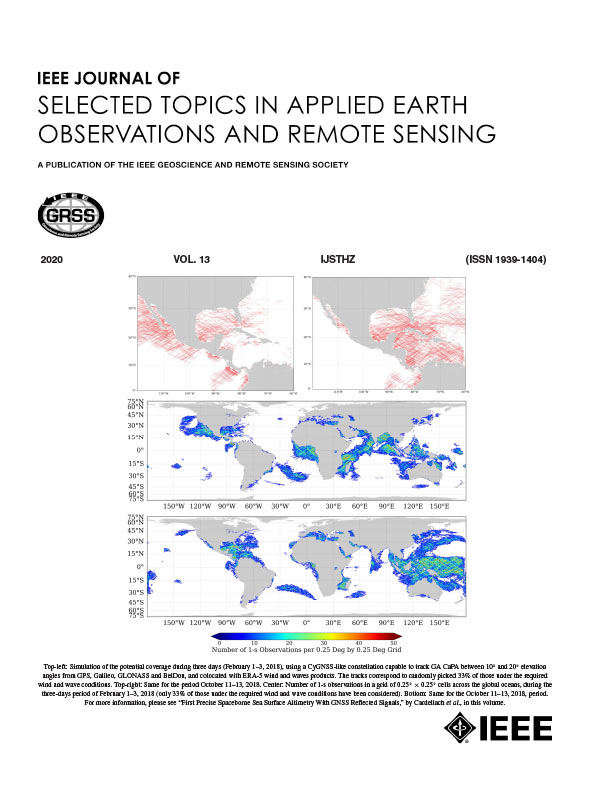A Multilevel Autoadaptive Denoising Algorithm Based on Forested Terrain Slope for ICESat-2 Photon-Counting Data
IF 4.7
2区 地球科学
Q1 ENGINEERING, ELECTRICAL & ELECTRONIC
IEEE Journal of Selected Topics in Applied Earth Observations and Remote Sensing
Pub Date : 2024-09-12
DOI:10.1109/JSTARS.2024.3459957
引用次数: 0
Abstract
In complex mountainous terrain, the terrain slope causes the scattering of pulsed lasers, generating a lot of noise in photon cloud data (PCD) collected from forestland, which seriously affects the accurate retrieval of forest structure parameters. To address this problem, a multilevel autoadaptive denoising (MLAD) algorithm was proposed in this article. First, random noise photons were removed through the ordering points to identify the clustering structure (OPTICS) algorithm in the coarse denoising process. Second, in the fine denoising step, the circular search domain in the OPTICS algorithm was replaced with an elliptical search domain. The photons after coarse denoising were automatically divided along-track direction into several continuous segments of 100 m each. The median slope method was used to automatically calculate the slope of the forested terrain in each interval segment, so that the range of the ellipse search domain was automatically adjusted to achieve accurate denoising of PCD. Finally, the denoising results of the MLAD algorithm in three different forested terrain areas were compared with those of the difference, regression, and Gaussian adaptive nearest neighbor (DRAGANN) algorithms, and the performance of the MLAD algorithm was evaluated for both different terrain slopes and different vegetation coverages. The results indicated that compared with the DRAGANN algorithm, the MLAD algorithm has higher denoising capability in different regions. The denoising results of the MLAD algorithm exhibit slight changes with the variation in slope, and the基于森林地形坡度的 ICESat-2 光子计数数据多级自适应去噪算法
在复杂的山地地形中,地形坡度会导致脉冲激光的散射,从而在林地采集的光子云数据(PCD)中产生大量噪声,严重影响森林结构参数的准确检索。针对这一问题,本文提出了一种多级自适应去噪(MLAD)算法。首先,在粗去噪过程中,通过排序点识别聚类结构(OPTICS)算法去除随机噪声光子。其次,在精细去噪步骤中,将 OPTICS 算法中的圆形搜索域替换为椭圆形搜索域。粗去噪后的光子被自动沿轨道方向划分为多个连续的片段,每个片段 100 米。利用斜率中值法自动计算每个区间段内森林地形的斜率,从而自动调整椭圆搜索域的范围,实现对 PCD 的精确去噪。最后,将 MLAD 算法在三个不同森林地形区的去噪结果与差分、回归和高斯自适应近邻(DRAGANN)算法进行了比较,并评估了 MLAD 算法在不同地形坡度和不同植被覆盖率下的性能。结果表明,与 DRAGANN 算法相比,MLAD 算法在不同区域具有更高的去噪能力。MLAD 算法的去噪结果随坡度变化而略有变化,F 值在 0.96 左右,表现出良好的鲁棒性。在不同植被覆盖度下,MLAD 算法的 F 值大多超过 0.95。总体而言,MLAD 算法在复杂森林环境中表现出较强的噪声识别能力。这些结果可为后续精确提取森林结构参数提供参考。
本文章由计算机程序翻译,如有差异,请以英文原文为准。
求助全文
约1分钟内获得全文
求助全文
来源期刊
CiteScore
9.30
自引率
10.90%
发文量
563
审稿时长
4.7 months
期刊介绍:
The IEEE Journal of Selected Topics in Applied Earth Observations and Remote Sensing addresses the growing field of applications in Earth observations and remote sensing, and also provides a venue for the rapidly expanding special issues that are being sponsored by the IEEE Geosciences and Remote Sensing Society. The journal draws upon the experience of the highly successful “IEEE Transactions on Geoscience and Remote Sensing” and provide a complementary medium for the wide range of topics in applied earth observations. The ‘Applications’ areas encompasses the societal benefit areas of the Global Earth Observations Systems of Systems (GEOSS) program. Through deliberations over two years, ministers from 50 countries agreed to identify nine areas where Earth observation could positively impact the quality of life and health of their respective countries. Some of these are areas not traditionally addressed in the IEEE context. These include biodiversity, health and climate. Yet it is the skill sets of IEEE members, in areas such as observations, communications, computers, signal processing, standards and ocean engineering, that form the technical underpinnings of GEOSS. Thus, the Journal attracts a broad range of interests that serves both present members in new ways and expands the IEEE visibility into new areas.

 求助内容:
求助内容: 应助结果提醒方式:
应助结果提醒方式:


